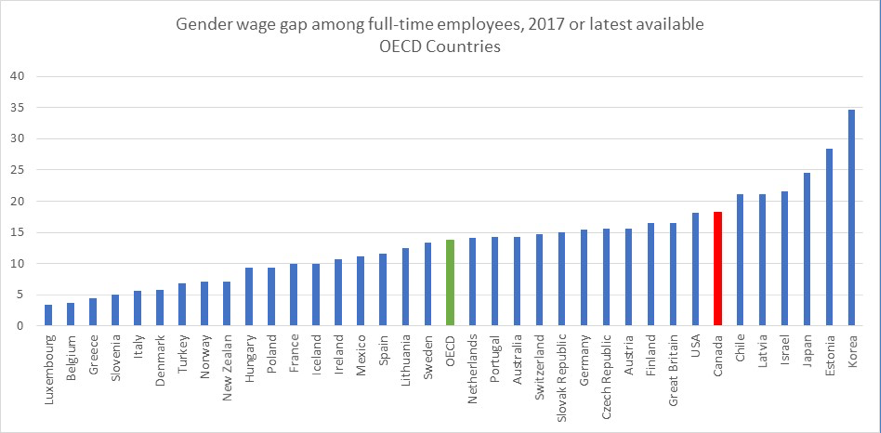Canada celebrated Equality Day this week: April 17th—the day when the Canadian Charter of Rights and Freedoms came into force over thirty years ago. It’s an especially important day for the women’s movement who won the guarantee that all rights and freedoms enshrined in the Charter would apply equally to women and men.
This year, the women’s movement is celebrating Canada’s new proactive pay equity law. The legislation, passed last December, requires that all federally-regulated employers with 10 or more employees ensure that men and women receive equal pay for work of equal value.It has been a long time coming.
Although equal pay for equal work has been enshrined in the Canadian Human Rights Act since 1977, the burden to file complaints with the Canadian Human Rights Commission was on employees. This system was patently unjust. Individual cases have taken decades to adjudicate while significant disparities in earnings persist. Canada’s pay gap remains one of the largest among OECD countries, ranking 30th out of 36 countries.

Source: OECD (2019), Gender wage gap (indicator). Note: Gender wage gap is defined as the difference between median earnings of men and women relative to median earnings of men.
But with the new legislation, employers will now be required to develop pay equity plans for their workplaces and take action to address systemic disparities, and a new Pay Equity Commissioner will be appointed to administer and enforce the Act. The government is currently developing the regulations needed to bring the Act into force, hopefully at some point next year after the election. A discussion paper will be circulated shortly to solicit community input—and there’s a lot to say.
Pay equity experts—most especially those who have been in the trenches for years negotiating pay equity plans and shepherding complaints through the existing system—raised serious concerns last year about proposed provisions that undermine the potential of the legislation to actually close the wage gap, concerns that were not addressed in the final text of the Bill.
As the process moves forward to develop the mechanics of the new federal system, there are several things that we’ll be tracking. Here are five key questions.
Will the Pay Equity Act uphold women’s fundamental right to equal pay for work of equal value?
The Act, as currently drafted, does not deliver robust, comprehensive and effective protection for women’s economic equality rights. The purpose of the Act “to achieve pay equity through proactive means” is subject to a qualifying phrase “while taking into account the diverse needs of employers”—a clause that is unprecedented in any other Canadian human rights legislation and actively subverts the legislation’s stated intent. This, along with other provisions, provide a considerable number of opportunities for employers to avoid their obligations and drag out the process.
Will the Act effectively protect the rights of non-unionized workers and others in precarious employment situations?
The Act, as currently drafted, allows for the exclusion of certain forms of compensation, such as the receipt of benefits, in calculating and comparing levels of compensation of different positions. These provisions will undercut potential pay equity awards due to temporary, casual and seasonal workers, in effect, amplifying the systemic inequities and precarity they already face. These workers will also confront significant barriers to their full and informed participation in the pay equity process.
Will the Act ensure that the Pay Equity Commissioner has the tools to enforce the Act?
Effective enforcement of pay equity rights requires that the legislation provide meaningful, effective and timely remedies for systemic wage discrimination for all groups of workers. Those rights must be enforced before a competent and expert tribunal and appropriate sanctions applied when there is a failure to comply.
Again, there are clear gaps in the current legislation. For example, it does not require employers to file their pay equity plans with the Pay Equity Commissioner. Instead, employers will be asked to submit an annual statement with limited information with respect to the status of pay equity in their workplaces. Without a meaningful base line, there will be no effective way to track progress or assess compliance.
Will the government ensure that the Pay Equity Commissioner has the budget to deliver on the goals of the Act?
The Commissioner’s mandate is very broad and challenging. In addition to oversight and enforcement, the Commissioner and the new Pay Equity Unit will also be responsible for providing technical assistance to employers, employees and pay equity committees, undertaking dispute resolution, and making decisions on the interpretation and application of the Act.Without significant investment, positive momentum will grind to a halt. Budget 2019 was silent on this question. The Pay Equity Coalition estimates that $80 million a year—and 50 dedicated pay equity enforcement officers—are needed to support the Commissioner’s mandate.[1] The Canadian Human Rights Commission itself as currently structured certainly does not have the capacity to undertake this work.[2]
These resources are critical to success—especially for outreach, education and support. The legislation is missing the key infrastructure to ensure access to justice, especially for non-unionized workers. Where will workers turn for advice and representation to protect their rights? The complexity of the process is daunting, and online tutorials aren’t going to cut it.
What will the new Pay Transparency measures look like?
In short, we won’t know until the government releases its proposals this summer. Pay transparency and proactive pay equity legislation work hand in hand to make sure that employers are delivering discrimination-free pay. Pay transparency establishes the right of employees and prospective employees to information about the pay regime by gender and position—and requires employers to submit this information by way of public reports each year. The bar needs to be high.
***
The Pay Equity Act has passed but the fight for an effective pay equity regime isn’t over. We must continue to push for a progressive and well-resourced system—supported by strong legislation and regulations—that facilitates the active participation of all workers and delivers on the promise of economic equality for women. If we fall short, we will be looking once again at decades of litigation, failed dreams, continued exploitation and economic hardship.
Katherine Scott is a Senior Economist with the Canadian Centre for Policy Alternatives. Follow her on Twitter @ScottKatherineJ.
[1] Jan Borowy and Fay Faraday (2018), “What women need for robust pay equity enforcement,” Briefing Note for Pay Equity Coalition.[2] The 2018-2019 estimated expenditures of the Canadian Human Rights Commission are $28.9 million. There are only 200 full-time equivalent employees at the Commission: 75 FTEs are assigned to complaints and 11 FTE enforce employment equity audits. The Commission received 1,083 complaints in 2017.


